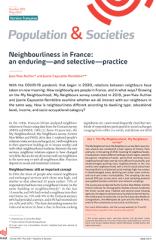
Neighbourliness in France: an enduring—and selective—practice
Population and Societies
n° 589, May 2021
With the COVID-19 pandemic that began in 2020, relations between neighbours have taken on new meaning. How neighbourly are people in France, and in what ways? Drawing on the My Neighbourhood, My Neighbours survey conducted in 2018, Jean-Yves Authier and Joanie Cayouette-Remblière examine whether we all interact with our neighbours in the same way. How is neighbourliness different according to dwelling type, educational level, income, and socio-occupational category?
Neighbour relations appear to have changed very little over the last 3 decades. But we do not all interact with our neighbours in the same way or with all neighbours alike. Neighbourliness increases with educational level and income. Relations are most frequent among those aged 30–44 and among homeowners and families with children. They are more pronounced in bourgeois and gentrified areas and in rural municipalities.
Jean-Yves Authier
Joanie Cayouette-Remblière

